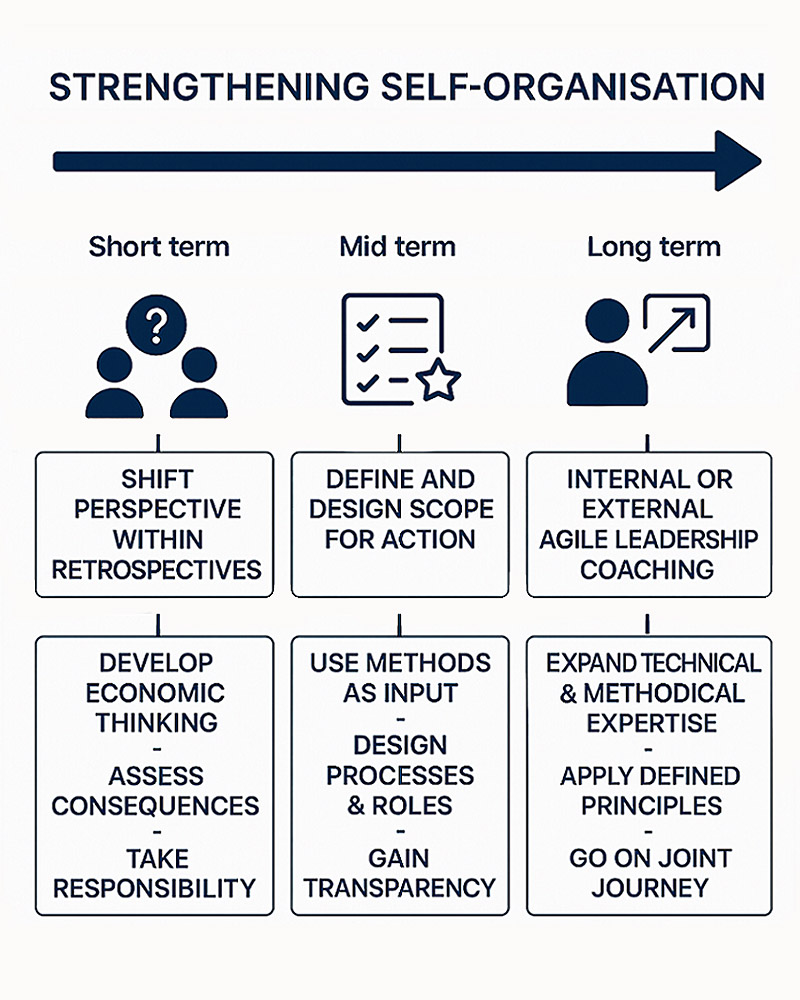Self-organised teams, yet everyone still asks the boss
How to strengthen self-organisation in the short, medium and long term
Almost all agile frameworks place a strong emphasis on self-organisation and make it a central focus. Accordingly, agile teams are expected to organise themselves independently. The central idea here is that the people who do the work are also best placed to make decisions about how it should be done. Self-organisation should help teams to solve complex problems better together and respond more quickly to change.
External intervention, for example by a manager, is not actually necessary and is sometimes even superfluous. Many agile frameworks contain concrete descriptions of how self-organisation can be structured and what applications are possible. Some assign the task of promoting self-organisation to specific agile roles, such as the Scrum Master or Agile Coach. These roles have the clear task of creating parameters that not only enable self-organisation, but also actively demand it.
In doing so, they must also be able to tolerate the fact that genuine self-organisation is sometimes uncomfortable, involves mistakes and challenges familiar power patterns. But this is precisely where its strength and greatest potential lie. After all, self-organisation does not mean that everything always runs smoothly or that there is always agreement. It requires the courage to openly resolve conflicts, to truly take responsibility and not automatically delegate it upwards.
Those who consistently follow this path will be rewarded with growing maturity, greater learning ability and a culture in which teams can develop themselves further.
The limits of self-organisation in practice
In practice, however, the limits of self-organisation often become apparent.
- How does a team deal with technical delays?
- How does it respond to sudden changes in customer requirements?
- How are conflicts resolved within the team?
- And how are resource bottlenecks overcome?
In such challenging situations, the simplest and most obvious solution is often the most obvious: let the boss decide. People who have little experience with agile collaboration are particularly quick to turn to the next higher authority when problems arise. However, this reflex is anything but helpful for the agility of the team and, in particular, for its self-organisation.
It is crucial, especially in such moments, to consciously remain within the team and develop viable solutions together. This is precisely where a great opportunity lies: practising self-organisation and strengthening confidence in one’s own ability to act. In the long term, this consistent negotiation within the team promotes the maturity and resilience of the collaboration.
Nevertheless, many agile teams find it difficult to maintain self-organisation in the long term without falling back into familiar patterns. This is not only due to a lack of experience, but often also to deeply ingrained patterns of thinking that have developed over many years. In numerous organisations, it has long been taught that real responsibility always lies with a manager and that it is safer to delegate critical decisions to higher levels. Especially in stressful situations or under high pressure, this reflex seems like a familiar way out. It is preferable to ask the boss than to bear the consequences yourself.
In addition, self-organisation requires a high degree of transparency, willingness to engage in conflict and mutual trust. However, all this cannot be achieved at the push of a button. A tension arises between the demand to work independently and the desire for guidance, security and clear guidelines. Enduring this ambivalence while remaining consistent in self-organisation is one of the greatest challenges of agile collaboration.
Strengthening self-organisation: From a change of perspective to agile leadership
In the short term, a change of perspective within agile retrospectives can provide helpful impetus. Particularly in important decision-making situations, it can be useful for the team to put themselves in the role of the person higher up in the hierarchy and ask themselves: How would we decide and act if we were fully responsible for the budget?
Such a change of perspective, supported by the joint development of solution techniques, can specifically promote self-organisation within the team. The mental shift towards economic responsibility leads to greater consideration of business aspects of decisions. At the same time, there is a growing awareness that responsibility always has consequences. As a result, decisions are increasingly made not only from a technical perspective, but also from a business perspective. In this way, the team gradually develops a self-image in which self-organisation and economic thinking are closely linked.
In the medium term, the team’s scope for action should be clearly defined on this basis. It is important to create transparency about which decisions can be made independently and where dependencies still exist. Methods such as Delegation Poker or Delegation Boards provide a structured basis for clarifying and expanding areas of responsibility step by step. At the same time, processes and working methods should not just be prescribed, but jointly designed and regularly reviewed. In retrospectives, the team can discuss what is working well and what should be adjusted in order to continuously improve. It is also helpful to openly define roles and responsibilities within the team and adjust them as needed. This creates clarity about who is responsible for what and where there is individual freedom. Even if certain roles are defined in agile frameworks, this does not mean that teams are permanently bound to them. They should constantly question and develop these roles.
In the long term, it is advisable to coach the team in the spirit of agile leadership. This can be done through internal or external support with a high level of technical and methodological expertise. Agile leadership is based on several fundamental principles that are closely interlinked. At its core is trust in people’s ability and willingness to take responsibility and actively contribute. This trust is not granted as a reward for performance, but is consciously given in advance to enable precisely this personal responsibility.
For self-organisation to succeed, a clear direction is also needed. Goals, vision and purpose must be communicated in a way that is easy to understand so that all team members understand where the journey is headed and how their work contributes to it. This direction can be developed by the team itself and reviewed and refined in regular feedback loops, for example every six months.
Figure: Strengthening self-organisation in the short, medium and long term
Self-organisation as a way of life and a genuine competitive advantage
Agile teams often differ significantly from traditionally hierarchical teams in the way they work, particularly when it comes to self-organisation. That’s why they should not only insist on practising this form of collaboration, but also actively work to strengthen it in their everyday work. In agile practice, this typically takes place in short, iterative improvement cycles within the team.
This creates a dynamic environment in which responsibility is continuously assumed and developed. At the same time, confidence grows that the best solutions will emerge from within the team itself. Especially in difficult moments, it is therefore worthwhile to stick to self-organisation. It is not just a term from theoretical descriptions, but the core of what makes agility come alive.
Only when teams make their own decisions can they react flexibly, become creative and take responsibility seriously. Of course, this is not always easy. Self-organisation sometimes requires patience, strength and nerves. But it is worth the effort. Instead of waiting for instructions from above, teams gain confidence in their actions and develop a clear sense of what works and what does not.
Over time, self-organisation becomes an integral part of the team’s identity. Teams become more independent, faster and more confident in their collaboration. This is where a real competitive advantage lies. In the end, the crucial question arises: Do teams really want to shape things, or would they rather wait until someone else decides? Those who preach self-organisation but drop it at the crucial moment should not be surprised if agility only exists on paper.
Notes:
Self-organisation is not a sure-fire success. Talk to Niklas Magerl about real agile leadership and how teams truly take responsibility – directly on LinkedIn.
Here you will find another article about the two faces of self-organisation.
Would you like to discuss this topic as an opinion leader? Then feel free to share this article on social media or within your network.
Niklas Magerl has published two more posts on the t2informatik Blog:

Niklas Magerl
Niklas Magerl is a business psychologist, university lecturer and experienced Scrum Master with a strong focus on agility and customer-oriented process design. In his role as Scrum Master, he ensures that technical developments are optimally aligned with the needs of internal customers in order to deliver software solutions with real added value. At the same time, he is a lecturer at the FOM University of Applied Sciences for Economics and Management, where he teaches students in the fields of project management, psychology and qualitative research methods.
In the t2informatik Blog, we publish articles for people in organisations. For these people, we develop and modernise software. Pragmatic. ✔️ Personal. ✔️ Professional. ✔️ Click here to find out more.


